加拿大介绍Canada Introduction
- 格式:pdf
- 大小:187.92 KB
- 文档页数:25

加拿大是世界上占地面积第2的国家。
面积比美国大,并且领土的延伸接近地球赤道的4分之1。
从东部到西部的距离超过5500千米。
并且加拿大覆盖了世界上24个时区中的6个。
加拿大的人口总数约为2900万,首都为渥太华。
其官方语言有2种,法语和英语。
1497年,从英格兰来的首批移居者(拓荒者)来到了这儿,1534年,从法国来的移居者也到达此地。
这来自两个国家的移居者为了成为这块土地的主宰者而互相征战。
今天,加拿大有一个说法语的省,电视和收音机里节目都是用法语播放的。
这儿有法式餐馆,所有的学校的教学都采用法语进行。
加拿大拥有世界淡水资源的3分之1。
在加拿大的南面有5大名湖。
并且在其他地方,尤其是在北部,还有许多湖。
加拿大主要是考水力发电。
它拥有大量的煤,石油,天然气资源。
这些都是完全可以作为能源来利用开发。
加拿大的大部分面积被森林覆盖,砍下来的木材被运往世界各地。
加拿大还是世界上供应制作报纸所需纸张的最大的供应者。
渔业在加拿大也是非常重要的。
来自东部和西部海岸的鱼被销售往世界其他国家。
加拿大Canada北美洲国家。
面积:约9,976,185平方千米。
人口:约31,081,900(2001)。
首都:渥太华。
英国人和法国人后裔占该国人口半数以上,德国人、意大利人、乌克兰人、华人、荷兰人、美洲印第安人和爱斯基摩人(因努伊特人)的后裔则构成重要的少数民族。
语言:英语和法语(均为官方语言)。
宗教:天主教、新教(加拿大联合教会和加拿大圣公会)。
货币:加拿大元。
加拿大可划分为几个自然地理区:以哈得孙湾为中心占全国面积近4/5的大片内陆盆地,由加拿大地盾、内陆平原及五大湖-圣劳伦斯低地区组成。
盆地边缘是几个大部为高地的区域,包括北极群岛境内的山脉,有落基山脉、海岸山脉和劳伦琴山脉。
境内最高峰位于育空地区的洛根山。
加拿大的5条河流――圣劳伦斯河、马更些河、育空河、弗雷泽河和纳尔逊河均居世界40条最大河流之列。
除与美国共有的苏必利尔湖和休伦湖外,加拿大的大熊湖和大奴湖又属世界11个最大湖泊之列。
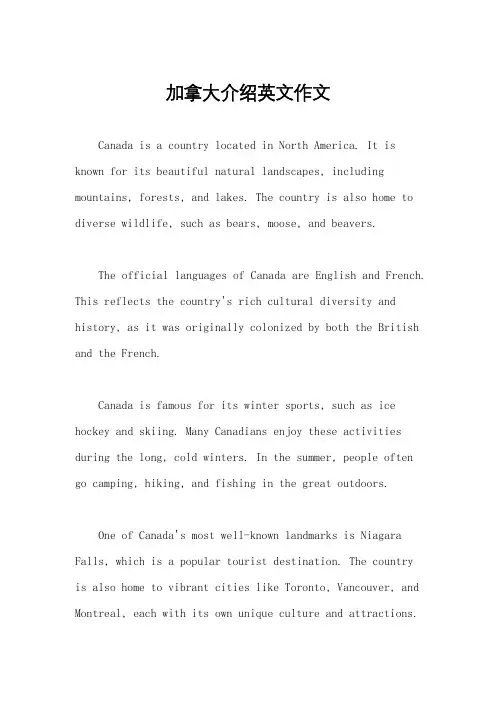
加拿大介绍英文作文Canada is a country located in North America. It is known for its beautiful natural landscapes, including mountains, forests, and lakes. The country is also home to diverse wildlife, such as bears, moose, and beavers.The official languages of Canada are English and French. This reflects the country's rich cultural diversity and history, as it was originally colonized by both the British and the French.Canada is famous for its winter sports, such as ice hockey and skiing. Many Canadians enjoy these activities during the long, cold winters. In the summer, people often go camping, hiking, and fishing in the great outdoors.One of Canada's most well-known landmarks is Niagara Falls, which is a popular tourist destination. The countryis also home to vibrant cities like Toronto, Vancouver, and Montreal, each with its own unique culture and attractions.The Canadian national dish is poutine, which is made of french fries, cheese curds, and gravy. It is a delicious and indulgent treat that can be found in restaurants across the country.Canada is also known for its politeness and friendliness. Canadians are often described as being very polite and welcoming, and this reputation is well-deserved.In conclusion, Canada is a beautiful and diverse country with a rich history and culture. From its stunning natural landscapes to its vibrant cities, there is something for everyone to enjoy in this great nation.。
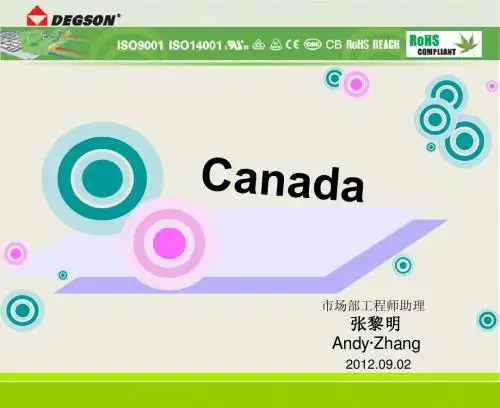
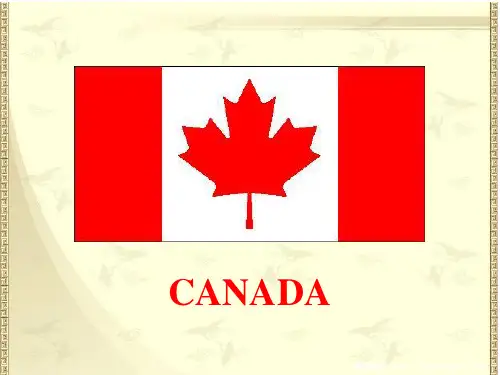
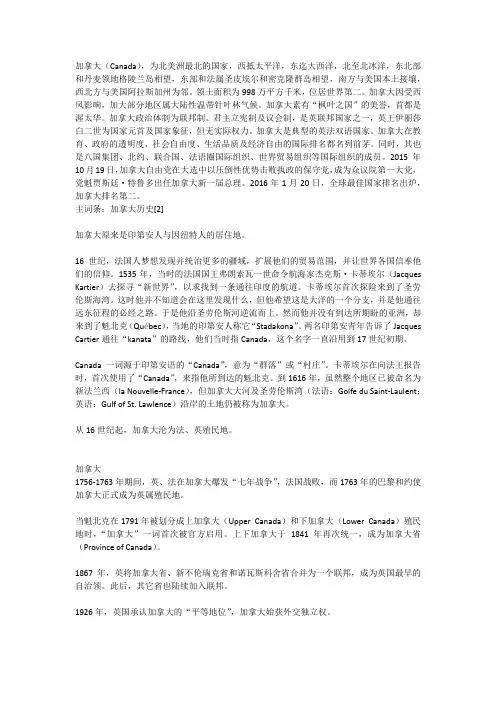
加拿大(Canada),为北美洲最北的国家,西抵太平洋,东迄大西洋,北至北冰洋,东北部和丹麦领地格陵兰岛相望,东部和法属圣皮埃尔和密克隆群岛相望,南方与美国本土接壤,西北方与美国阿拉斯加州为邻。
领土面积为998万平方千米,位居世界第二。
加拿大因受西风影响,加大部分地区属大陆性温带针叶林气候。
加拿大素有“枫叶之国”的美誉,首都是渥太华。
加拿大政治体制为联邦制、君主立宪制及议会制,是英联邦国家之一,英王伊丽莎白二世为国家元首及国家象征,但无实际权力。
加拿大是典型的英法双语国家。
加拿大在教育、政府的透明度、社会自由度、生活品质及经济自由的国际排名都名列前茅。
同时,其也是八国集团、北约、联合国、法语圈国际组织、世界贸易组织等国际组织的成员。
2015年10月19日,加拿大自由党在大选中以压倒性优势击败执政的保守党,成为众议院第一大党,党魁贾斯廷·特鲁多出任加拿大新一届总理。
2016年1月20日,全球最佳国家排名出炉,加拿大排名第二。
主词条:加拿大历史[2]加拿大原来是印第安人与因纽特人的居住地。
16世纪,法国人梦想发现并统治更多的疆域,扩展他们的贸易范围,并让世界各国信奉他们的信仰。
1535年,当时的法国国王弗朗索瓦一世命令航海家杰克斯·卡蒂埃尔(Jacques Kartier)去探寻“新世界”,以求找到一条通往印度的航道。
卡蒂埃尔首次探险来到了圣劳伦斯海湾。
这时他并不知道会在这里发现什么,但他希望这是大洋的一个分支,并是他通往远东征程的必经之路。
于是他沿圣劳伦斯河逆流而上。
然而他并没有到达所期盼的亚洲,却来到了魁北克(Québec),当地的印第安人称它“Stadakona”。
两名印第安青年告诉了Jacques Cartier通往“kanata”的路线,他们当时指Canada,这个名字一直沿用到17世纪初期。
Canada一词源于印第安语的“Canada”,意为“群落”或“村庄”。
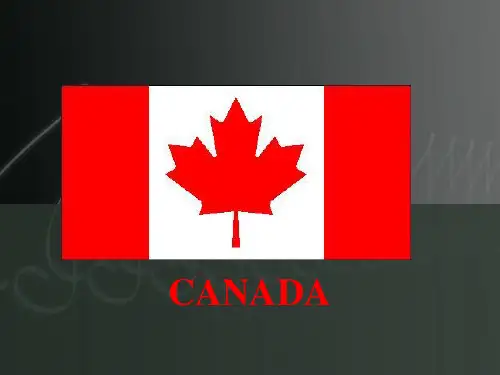
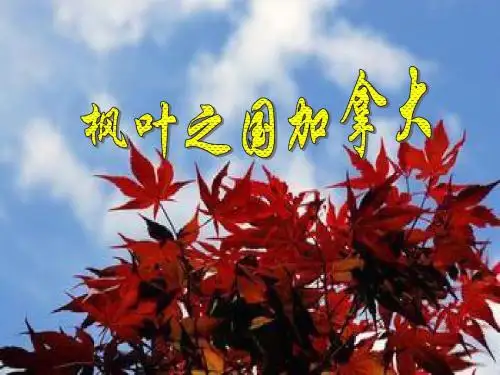
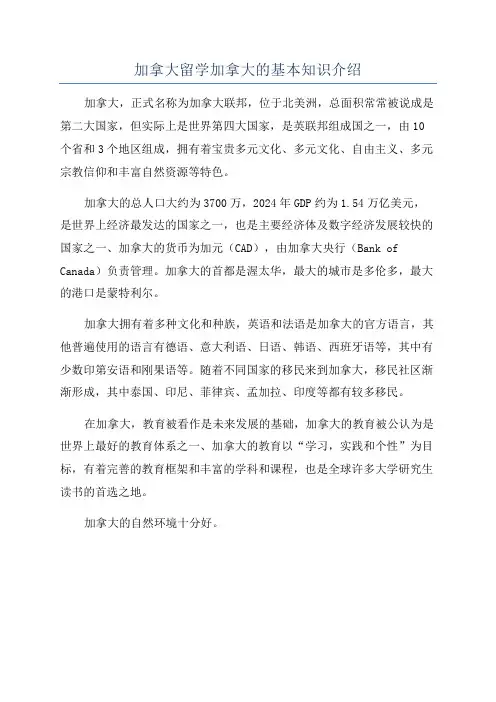
加拿大留学加拿大的基本知识介绍
加拿大,正式名称为加拿大联邦,位于北美洲,总面积常常被说成是第二大国家,但实际上是世界第四大国家,是英联邦组成国之一,由10个省和3个地区组成,拥有着宝贵多元文化、多元文化、自由主义、多元宗教信仰和丰富自然资源等特色。
加拿大的总人口大约为3700万,2024年GDP约为1.54万亿美元,是世界上经济最发达的国家之一,也是主要经济体及数字经济发展较快的国家之一、加拿大的货币为加元(CAD),由加拿大央行(Bank of Canada)负责管理。
加拿大的首都是渥太华,最大的城市是多伦多,最大的港口是蒙特利尔。
加拿大拥有着多种文化和种族,英语和法语是加拿大的官方语言,其他普遍使用的语言有德语、意大利语、日语、韩语、西班牙语等,其中有少数印第安语和刚果语等。
随着不同国家的移民来到加拿大,移民社区渐渐形成,其中泰国、印尼、菲律宾、孟加拉、印度等都有较多移民。
在加拿大,教育被看作是未来发展的基础,加拿大的教育被公认为是世界上最好的教育体系之一、加拿大的教育以“学习,实践和个性”为目标,有着完善的教育框架和丰富的学科和课程,也是全球许多大学研究生读书的首选之地。
加拿大的自然环境十分好。
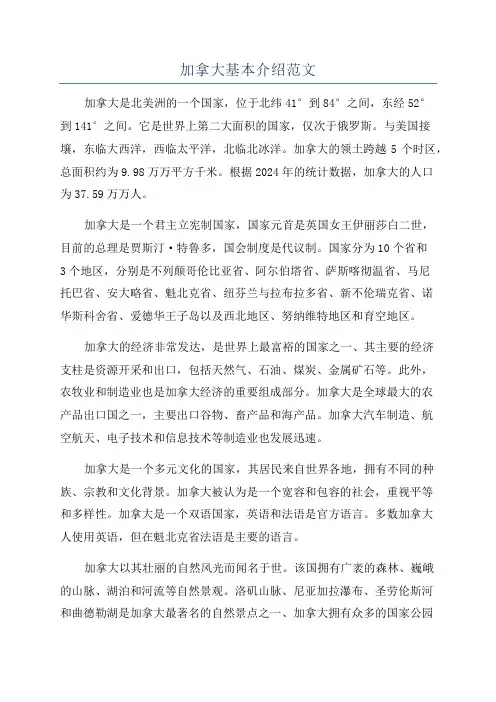
加拿大基本介绍范文加拿大是北美洲的一个国家,位于北纬41°到84°之间,东经52°到141°之间。
它是世界上第二大面积的国家,仅次于俄罗斯。
与美国接壤,东临大西洋,西临太平洋,北临北冰洋。
加拿大的领土跨越5个时区,总面积约为9.98万万平方千米。
根据2024年的统计数据,加拿大的人口为37.59万万人。
加拿大是一个君主立宪制国家,国家元首是英国女王伊丽莎白二世,目前的总理是贾斯汀·特鲁多,国会制度是代议制。
国家分为10个省和3个地区,分别是不列颠哥伦比亚省、阿尔伯塔省、萨斯喀彻温省、马尼托巴省、安大略省、魁北克省、纽芬兰与拉布拉多省、新不伦瑞克省、诺华斯科舍省、爱德华王子岛以及西北地区、努纳维特地区和育空地区。
加拿大的经济非常发达,是世界上最富裕的国家之一、其主要的经济支柱是资源开采和出口,包括天然气、石油、煤炭、金属矿石等。
此外,农牧业和制造业也是加拿大经济的重要组成部分。
加拿大是全球最大的农产品出口国之一,主要出口谷物、畜产品和海产品。
加拿大汽车制造、航空航天、电子技术和信息技术等制造业也发展迅速。
加拿大是一个多元文化的国家,其居民来自世界各地,拥有不同的种族、宗教和文化背景。
加拿大被认为是一个宽容和包容的社会,重视平等和多样性。
加拿大是一个双语国家,英语和法语是官方语言。
多数加拿大人使用英语,但在魁北克省法语是主要的语言。
加拿大以其壮丽的自然风光而闻名于世。
该国拥有广袤的森林、巍峨的山脉、湖泊和河流等自然景观。
洛矶山脉、尼亚加拉瀑布、圣劳伦斯河和曲德勒湖是加拿大最著名的自然景点之一、加拿大拥有众多的国家公园和保护区,其中包括洛矶山脉国家公园、万锦湖国家公园和贾斯珀国家公园。
这些地方吸引着大量的游客,提供了徒步旅行、滑雪、钓鱼等户外活动的机会。
加拿大还以其高质量的教育系统闻名于世。
加拿大的大学和学院在全球范围内享有很高的声誉。
该国的教育体系注重学术和职业结合,培养出高素质的毕业生。
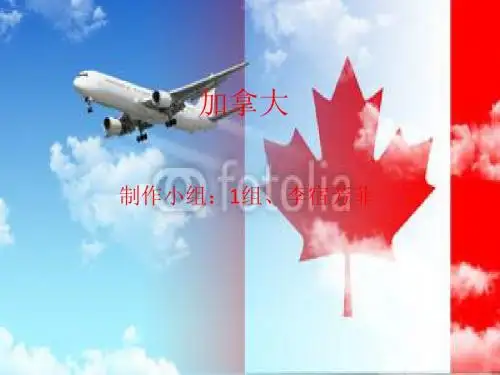

加拿大简介第一篇:加拿大简介加拿大位于北美洲的最北端,是世界第二大国家,仅次于俄罗斯。
它东临大西洋,西濒太平洋,北界北冰洋,南极北太平洋。
加拿大土地辽阔,面积总计超过9.98万平方公里。
它与美国为邻,两国之间拥有世界上最长的陆地边界。
加拿大被誉为“枫叶之国”,枫树叶也是其国旗上的标志性图案。
加拿大的政治制度是一个联邦制国家,国家元首是英国女王,目前为伊丽莎白二世。
加拿大的宪法和政治遵循英国的模式,提倡民主制度和权力分立。
国家总理是政府的首要领导人,根据选举结果产生。
议会制度是常规的行政决策方法。
加拿大是一个多文化的社会,它拥有多种不同的种族和文化背景。
英语和法语是加拿大的官方语言,分别被使用于不同的地区,其中英语在大部分地区广泛使用,而法语主要在魁北克省使用。
这种文化多样性使得加拿大成为一个充满活力和包容的国家。
加拿大广大的土地也为各种自然资源提供了丰富的资源,如石油、矿产和水力能源。
加拿大是一个高度发达的国家,拥有着世界上最高的人均收入之一。
它的经济体系是以服务行业为主导,包括旅游、金融、教育和医疗保健等领域。
此外,加拿大也是一个重要的国际贸易国家,其主要出口产品包括能源、汽车、木材和农产品。
加拿大以其优越的生活质量和良好的社会福利享誉全球。
作为一个富裕的国家,加拿大注重公共教育和医疗保健体系的发展,以确保所有公民都能享受到高质量的教育和医疗保健服务。
此外,加拿大还重视环境保护和可持续发展,并采取了许多措施来保护其自然景观和生态系统。
总的来说,加拿大是一个文化多元、自然资源丰富、社会福利完备的发达国家。
它的美丽景色、友好社会氛围和良好的生活条件吸引着来自世界各地的人们。
无论是旅游还是移民,加拿大都是一个备受推崇的目的地。
第二篇:加拿大的地理和自然景观加拿大是一个以其壮丽的自然景观而闻名于世的国家。
它的地理特点使得加拿大拥有了多样而壮观的景色,吸引着众多游客和自然爱好者。
下面简要介绍加拿大的地理和自然景观。
介绍加拿大的作文英语作文Canada is a vast and diverse country, known for its breathtaking natural beauty, friendly people, and richcultural heritage. It is the second largest country in the world by land area, stretching from the Atlantic to thePacific Ocean, and from the Arctic Ocean to the United States border.Geographically, Canada is divided into ten provinces andthree territories. Each region has its own unique landscape, from the rugged coastline of British Columbia to the rolling prairies of Alberta and Saskatchewan, to the lush forests of Quebec and Ontario. The country is also home to the Rocky Mountains, one of the most famous mountain ranges in the world, which offer stunning vistas and a plethora of outdoor activities.Canada's population is a mosaic of cultures, with a historyof immigration that has contributed to a rich tapestry of traditions and customs. The official languages are Englishand French, reflecting the country's bilingual heritage. Canadians are known for their politeness and welcoming nature, making it a great place for international students and tourists.Economically, Canada is a developed nation with a strong presence in industries such as technology, natural resources, and manufacturing. It has a high standard of living, with awell-developed education system and healthcare services. The country is also a leader in environmental conservation, with numerous national parks and protected areas.Culturally, Canada has a thriving arts scene, with world-class museums, galleries, and performing arts centers. The country hosts many festivals throughout the year, including the Toronto International Film Festival and the Montreal Jazz Festival, which attract visitors from around the globe.In sports, Canada is particularly famous for its love of ice hockey, which is considered the national winter sport. The country has also made significant achievements in winter sports at the Olympic level, as well as in other sports like basketball and baseball.Canada's political system is a parliamentary democracy and a constitutional monarchy, with Queen Elizabeth II as the head of state and a Prime Minister as the head of government. The country prides itself on its democratic values and commitment to human rights.In conclusion, Canada is a country of contrasts, offering a mix of natural wonders, cultural diversity, and modern amenities. It is a place where people from all walks of life can find a welcoming community and a high quality of life. Whether you are interested in exploring the great outdoors, engaging with the arts, or simply experiencing a different way of life, Canada has something to offer everyone.。
介绍加拿大英语作文加拿大英语作文范文:Canada is a country located in the northern part of North America. It is the second largest country in the world by total area, and it is known for its beautiful landscapes, diverse culture, and high quality of life. In this essay, I will introduce Canada from several aspects, including its geography, culture, and education system.Firstly, Canada is a country with stunning natural beauty. It is home to vast forests, majestic mountains, and crystal-clear lakes. The country is also known for its wildlife, including polar bears, moose, and beavers. In addition, Canada has a diverse climate, ranging from the freezing temperatures of the Arctic to the mild weather of the southern regions. The natural beauty of Canada makes it a popular destination for tourists and outdoor enthusiasts.Secondly, Canada is a multicultural country with a richand diverse culture. The country is home to people from all over the world, and it is known for its tolerance and acceptance of different cultures and beliefs. Canada's multiculturalism is reflected in its food, music, art, and festivals. The country celebrates a wide range of cultural events, such as the Calgary Stampede, the Toronto International Film Festival, and the Montreal International Jazz Festival. Canada's multiculturalism is also evident in its official languages, English and French, which are spoken by the majority of the population.Finally, Canada has a world-renowned education system. The country is known for its high-quality education, and it consistently ranks among the top countries in the world in terms of educational achievement. Canada's education system is characterized by its focus on critical thinking, creativity, and innovation. The country is home to several prestigious universities, such as the University of Toronto, McGill University, and the University of British Columbia. These institutions offer a wide range of programs and research opportunities for students from around the world.In conclusion, Canada is a country with a lot to offer. Its natural beauty, diverse culture, and high-quality education system make it an attractive destination for people from all over the world. Whether you are interested in exploring the great outdoors, experiencing different cultures, or pursuing a world-class education, Canada has something for everyone. I hope that this essay has given you a better understanding of what Canada has to offer. Thank you for reading.。
An Introduction to Canada for Sixth GradersHello everyone! Today, I’m excited to introduce you to the beautiful country of Canada. As sixth graders, you’re at the perfect age to start exploring the amazing facts about different countries, and Canada is a great place to start. Let’s dive into some interesting aspects of this wonderful nation.Geography and NatureCanada is the second-largest country in the world by land area, only behind Russia. It is located in North America and shares its southern border with the United States. Canada has ten provinces and three territories, each with its unique landscapes and cultures.One of the coolest things about Canada is its diverse geography. You can find everything from the majestic Rocky Mountains in Alberta and British Columbia to the beautiful coastlines of Nova Scotia and Newfoundland. Canada is also home to many lakes and forests, making it a paradise for nature lovers. Did you know that Canada has more lakes than any other country in the world? One of the most famous is Lake Superior, which is the largest freshwater lake by surface area in the world.WildlifeCanada is home to a wide variety of wildlife. You might see animals like moose, beavers, bears, and even polar bears if you’re in the northern parts of the country. Canada’s national animal is the beaver, which is known for building impressive dams in rivers and streams.ClimateCanada’s climate can vary greatly depending on where you are. In the winter, some parts of Canada, especially the northern areas, can get very cold with lots of snow. In contrast, cities like Vancouver have milder winters with more rain than snow. Summers can be warm and pleasant, making it a great time for outdoor activities.People and CultureCanada is known for being a very diverse and multicultural country. People from all over the world live in Canada, bringing their customs, traditions, and cuisines. This makes Canada a very exciting place to learn about different cultures.The country has two official languages: English and French. Most people in Canada speak English, but in the province of Quebec, French is the primary language. It’s common to hear both languages spoken, especially in bilingual cities like Montreal.Canadian Traditions and CelebrationsCanadians celebrate a variety of holidays and traditions. One of the most important holidays is Canada Day, celebrated on July 1st. It marks the anniversary of the founding of Canada in 1867 and is celebrated with fireworks, parades, and parties across the country.Another fun winter tradition is ice hockey. It’s considered Canada’s national winter sport and is very popular among Canadians. Many kids start playing hockey at a young age, and it’s exciting to watch the games, especially when the national team competes in international tournaments.Famous LandmarksCanada has many famous landmarks that are worth knowing about. Here are a few:1.Niagara Falls: One of the most famous waterfalls in the world, located on the borderbetween Canada and the United States. Tower: Located in Toronto, it was once the world’s tallest free-standing structure andoffers amazing views of the city.3.Banff National Park: A beautiful national park in the Rocky Mountains, perfect for hiking,skiing, and seeing wildlife.GovernmentCanada is a democratic country with a parliamentary system. The Prime Minister is the leader of the government. Canada is also a part of the British Commonwealth, which means that while it is an independent country, it recognizes the British monarch as the ceremonial head of state.Fun Facts•Canada’s flag has a red maple leaf, which is a national symbol.•Poutine, a delicious dish made of fries, cheese curds, and gravy, originated in Canada.•The northern lights, or aurora borealis, can often be seen in Canada’s northern regions.In conclusion, Canada is an amazing country with stunning natural beauty, diverse cultures, and a rich history. It’s a place where you can experience snowy winters, enjoy multicultural festivals, and explore vast wilderness. I hope you enjoyed learning a bout Canada, and maybe one day you’ll get to visit this incredible country yourself!Thank you for listening!。
Canada IntroductionCanada has a population just less than 30 million people in a country twice the area of the United States. The heritage of Canada was French and English; however, significant immigration from Asia and Europe's non-French and English countries has broadened Canada's cultural richness. This cultural diversity is considered a national asset, and the Constitution Act prohibits discrimination against individual citizens on the basis of race, color, religion, or sex. The great majority of Canadians are Christian. Although the predominant language in Canada is English, there are at least three varieties of French that are recognized: Quebecois in Quebec, Franco-Manitoban throughout Manitoba and particularly in the St. Boniface area of Winnipeg, and Acadian. The Italian language is a strong third due to a great influx of Italian immigrants following W.W.II. Canada's three major cities are distinctively, even fiercely different from one another even though each is a commercially thriving metropolitan center. Montreal, established in the 17th century and the largest French city outside France, has a strong influence of French architecture and culture. It is a financial and manufacturing centerand seaport, with the majority of Canada's European exports and imports coming through its harbor. Toronto, another major financial and commercial center, is filled with office towers not historic buildings. It has a great number of people living in and around the central business district. The downtown district does not "close up" when people leave work. Vancouver, nestled at the base of the Coast Mountains, is the financial, commercial, agricultural, and industrial center for western Canada. It's harbor and mountains make it one of Canada's most picturesque. Consequently, West Vancouver is the most densely populated urban area and has the highest income per person of any municipality.Canada Fun FactThe western frontier was "opened" in 1885 when the Canadian transcontinental railroad completed its peaceful construction process. The railroad offered cheap land so immigrants moved in communities establishing towns with citizens from the same European country. These settlements, along with the Inuit communities, give Canada cultural diversity across its nation, not just in major metropolitan cities. Keep in mind that Quebec, because it is a French province, has a verydifferent value system from the rest of Canada, with its predominately English influence.Geert Hofstede Analysis for CanadaThe majority of Canadians, as well as citizens of other English speaking countries, (see Great Britain, Australia, New Zealand, and the United States) have individualism ranked highest. Success is measure by personal achievement. Canadians tend to be self-confident and open to discussions on general topics; however, they hold their personal privacy off limits to all but the closest friends. It should be noted there is tension between the French province of Quebec and other Canadian provinces. Citizens of Quebec tend to be more private and reserved. Ethnocentrism is high throughout Canada, but particularly in Quebec.Canada has Individualism (IDV) as the highest ranking (80) Hofstede Dimension, and is indicative of a society with a more individualistic attitude and relatively loose bonds with others. The populace is more self-reliant and looks out for themselves and their close family members. Privacy is considered the cultural norm and attempts at personal ingratiating may meet with rebuff.The majority of Canadians, as well as citizens ofother English speaking countries, (see United Kingdom, Australia, New Zealand, and the United States) have Individualism as their highest ranking Dimension.Among high IDV countries, success is measured by personal achievement. Canadians tend to be self-confident and open to discussions on general topics; however, they hold their personal privacy off limits to all but the closest friends .Canadian's lowest ranking Dimension is Long Term Orientation at 23, compared to the average of 45 among the 23 countries surveyed for which scores have been calculated. This low LTO ranking is indicative of societies' belief in meeting its obligations and tends to reflect an appreciation for cultural traditions.Canada's Power Distance (PDI) is relatively low, with an index of 39, compared to a world average of 55. This is indicative of a greater equality between societal levels, including government, organizations, and even within families. This orientation reinforces a cooperative interaction across power levels and creates a more stable cultural environment.It should be noted there is tension between the French province of Quebec and other Canadianprovinces. Citizens of Quebec tend to be more private and reserved. Ethnocentrism is high throughout Canada, but particularly in Quebec. This may be in part due to the difference in religious background of the French population, predominately Catholic, and the English population, predominantly Christian.The predominant religions in Canada are Catholic 42% and Christian 40%, but the population is somewhat segregated, with a high percentage of French Catholic's in Quebec. Note that the predominant religion in France is Catholic (83%) and in the United Kingdom is Christian (70%).Appearance in CanadaPlan for a very cold climate, especially during their winter.Men should wear a dark conservative business suit with tie, especially in cities. Build a wardrobe based on classic lines (selecting suits with a traditional lapel width, and ties staying within a traditional width range). Conservative colors of navy and gray, and shirts in white and light blue.Women should wear a conservative business suit or dress, especially in cities. Select yourclothing with classic lines and colors in mind. Navy, gray, ivory, and white are the basics to work with. The major cities can be very sophisticated.New or trendy clothing is a poor choice. Older, classic clothing that is clean and neat is more valued. Choosing quality, natural fibers for your wardrobe will give you this look. Quality leather shoes are important to completing this look.Rural areas are less formal, but stay conservative in your wardrobe. Even with cold winter weather you may find yourself in a skirt or dress. Add a good quality long coat with minimal and classic detail to your wardrobe. In addition to navy and gray, a classic camel coat, or a lined Burberry may be a good addition. This will work for a sophisticated city meeting, or a more casual rural meeting.Casual attire is appropriate when you are not working. The weather and activity will dictate what you will be wearing. Build a casual wardrobe using the classic colors (camel is additional color for casual). You will look professional, even though relaxed.The "V for Victory" sign is an insult if your palm is facing yourself. If you must use this sign, face your palm outward.Behavior in CanadaBe punctual for meetings and appointments, as promptness is valued. In French areas, time is more relaxed. However, you will be expected to arrive at the appointed time, even if the French attending the meeting don't.Always maintain a reserved demeanor, and follow good rules of etiquette. Traditions and gracious manners are part of the culture, even in more rural areas. If you travel to different cities or areas, pay attention to local customs. By being observant, you will respect the pace and nuances of each area.Do not eat while walking in public. Plan your time so you can stop in a café or restaurant to enjoy your snack.Gifts are not routinely given. If you do give a gift when you arrive or when you are leaving, make it a modest one. A lavish gift, though accepted, would be frowned upon.Gifts are given to celebrate finalizing a negotiation, a contract, or a project. Gifts for the office, a nice bottle of wine or liquor would be appropriate.Taking a business associate to a nice meal or an evening sporting event, play, or symphony is always a nice gesture.Invitations to private homes are rare. Occasionally, in the western provinces, you may be invited to someone's home. If you are invited, you may take candy, flowers, or liquor to the host or hostess.Wait for your host to start a business conversation during or following a meal. Traditionally, business is not discussed during dinner; however, this is slowly changing.Personal space and body movement or gestures differ between the English and the French provinces and cities. In English areas, body movement is minimal, there is rarely touching other than handshakes, and personal space - how close someone stands - is about two feet. In French areas, people stand closer together,people will frequently touch, and gestures are more expressive.Communications in CanadaUse a firm handshake with good eye contact when meeting and leaving. Both French and English areas use and expect a firm handshake.Men will wait for a woman to extend her hand for a handshake.French Canadians will shake hands more frequently, even with a subsequent encounter the same day. Others may just nod or smile at a subsequent encounter on the same day.Use a person's title if he or she has one. Otherwise, use Mr., Mrs., Miss and the surname.English is spoken in most of Canada. French is spoken in Quebec, and some area of Nova Scotia and New BrunswickFrench Canadians may use their first name when talking to you on the telephone, but will generally use their full name when meeting you in person.Be open and friendly in your conversation. If youare naturally reserved in your behavior, you will appear confident and credible. If your natural tendency is large sweeping arm gestures, restrain yourself when meeting and talking with Canadians- other than with French Canadians.French Canadians stand closer and are more demonstrative when talking.For French Canadians, print all material in French and English.Don't be boastful, and don't overstate yourproduct or service's capabilities. You couldimplicate your company in a legal situation.If you are from the U. S., don't say, "we Americans", inferring you are including your Canadian hosts or guests in your reference.Canada is a distinct country with its ownwonderful history and culture.AFTER YOU ARRIVEOnce you arrive in Canada, it's a great idea to get involved in your new community right away, even before you feel the possible effects of home-sickness. Your new school will likely have activities and programs for international students, as well as opportunities to talk with both peers and counsellors about any problems or concerns you might have.It's also a good idea to get involved with other activities on campus, and to make friends with Canadian students. Most schools have clubs, recreationalsports or other activities and organizations available for students to join, including film clubs, running clubs or musical groups and organizations. There are also independent immigrant associations in most cities aimed at helping new arrivals to Canada settle in. Your university or local Citizenship and Immigration Canada (CIC) office will be able to give you a list of such societies and associations. All of these organizations and activities provide the opportunity to make friends and be better integrated into the community, reducing your chances of loneliness or isolation.Be patient with yourself and with other people, and never be afraid to ask for help. Canadians in general are a friendly, open people and are happy to help you feel more welcome.List of Canadian slang words orphrases2-4 — (two four) a case of 24 beer ("Beer"being the plural of "Beer" in much ofCanada.)26er (also 2-6, twixer) — a 262⁄3 imperial fl oz(758 ml) in earlier times, or 750 ml (26.4 fl oz) bottle ofalcohol40 — a 40 fl oz (1 imperial quart, 1.14 L) bottle of alcohol.(see forty pounder)66er — a former 66.6 imperial fl oz (1/2 U.S. gallon, 1.89 L)bottle of alcohol, probably also applied to 1.75 L (61.6imperial fl oz) bottles (see gripper)"AADAC" (ay-dack) from the Alberta Alcohol and DrugAbuse Commission, used to refer to any sort of beveragewhich would get you drunk thus making you prime candidatefor alcohol addiction.alcool — grain alcohol; everclear (from French, but pronounced as in English)The Ballet — Strip club, or exotic dance club.Baywop — Someone living in a rural area centered around abay. Mostly used in Newfoundland. A pejorative term. Beaner — Someone living in a planned housing area.Refers to "The Bean", an area of planned housing inCorner Brook, Newfoundland and Labrador. "The Bean" is also known as Jellybean Square, referring to the colorful choices of house paint at the time it acquired its nickname.Beaver Tail (BeaverTail) — A dessert food basically consisting of a pastry, covered in maple syrup and othertoppings. Given its name because it resembles the shape ofa beaver's tail. Also known as an Elephant Ear.BiWay — see ZellersBlochead — A member of the Bloc Qu?becois.Blue Neck, Blueneck — Canadian version of thestereotypical American Redneck. Whereas the American neck derives its red colour from exposure to the sun, it isassumed the Canadian's blue colouring is the result offrostbite.Buck — unit of 100, most commonly directly replaces"dollar" ($1.25 — "a buck twenty five", $1.50 — "a buck fifty"), also used to describe highway speed ("I got caughtdoing a buck-thirty on the 401" meaning "I was caught driving at a speed of 130km/h on Highway 401")Buds — the Toronto Maple Leafs hockey team, also marijuanabunnyhug — a hooded sweatshirt without azipper(Saskatchewan)by — A term from Newfoundland. The equivelant of "man," "dude," or "pal." Example: Go on, 'by.Caker — is short for "Mange Cake" (pronounced manjacake, Italian for "cake-eater") and refers to Canadians ofAnglo origin. It is said that the term originated in Italian-Canadian kitchens as a type of mockery of AnglophoneCanada's bland cultural and culinary habits.Canuck — Canadian. Often used in the US as well,sometimes derogatorily. (properly someone fromVancouver)Chinook — A warm, dry wind experienced along the easternside of the Rocky Mountains in the United States andCanada. Most common in winter and spring, it can result ina rise in temperature of 20 ?C (35 to 40 ?F) in a quarter ofan hour.Cherrypicker — Somebody who stays around the opposingteams goalie and does not play defence. Similiar to GoalSuck.Chesterfield — a couch or sofa.chocolate bar — a candy bar, whether it actually containschocolate or not.click — kilometre or kilometres per hour (sometimes spelled "klick").CFA (Comes-From-Away) — a term used in the Atlanticprovinces to refer to visitors or residents who were not bornand raised in Eastern Canada. This term can be used in anaffectionate manner, or an exclusionary manner.Constab — pronounced cun-STAB; the police in cities of Newfoundland and Labrador serviced by the Royal Newfoundland Constabulary.Cougar — a middle-aged (or above) woman, dressed to thenines, out on the prowl looking for young (20–35 year old)menCrappy Tire or Ukrainian Tire— Canadian Tiredeke, deke out — to feint, to trick or avoid someone "to dekeout of a meeting" or, to deftly maneuver around a sportingopponent (esp. in hockey)dep — corner store, adapted from Quebec French word "d?panneur", especially by English-speaking Quebeckers.dick, dick all — nothingDipper — a member of the New Democratic Party Dogan — a Catholic; abusive, and now dying outdouble-double — a coffee with double cream, double sugar (especially, but not exclusively, from Tim Hortons). Triple-triple and four-by-four (less common) are three and four creams/sugars, respectively.eh — a spoken interjection to ascertain the comprehension, continued interest, agreement, etc., of the person or persons addressed (e.g. "That was a good game last night, eh?"). May also be used instead of huh? or what?. Meaning please repeat or say again.Farmer vision (also Peasant Vision, Country Cable or TFC -'Three Friggin' Channels') — The basic three TV channelsthat can be picked up almost anywhere (Global, CBC, CTV).Fish Police (also Tree Cop and Critter Cop) — Derogatoryreference to Federal or Provincial Fisheries or WildlifeOfficers.F.O.B— - Means fresh off the boat, and can be a derogatoryterm aimed at newly arrived immigrants, although commonlyused affectionately to describe any new resident of Canada.Often used amongst youth to describe exchange students,or fellow long-term visiting peers. Similar to American FES,or Foreign Exchange Student.fock — Alternate spelling/pronunciation of "Fuck" usedprimarily by francophones while speaking english (not to be confused with phoque, the french word for seal)forty pounder (forty ouncer) — a 40 oz. bottle of alcohol (see 40)Frog — A derogatory name given to French Canadians Frosh — A politically correct term for first-year students, derived from freshman.French fry — A derogatory name given to French Canadians, particularly in New Brunswick: see Square Head/English MuffinFuck the dog — A term used to indicate doing nothing (e.g. "I fucked the dog all weekend").ghetto blaster — a portable stereo system. The term was common throughout North America at one time, but is still common in Canada.Gina — a female (usually of Mediterranean descent) who dresses in tight clothing usually with fluffy accents; Ginas are usually only labelled as such because of their association with Ginos (see below) (this word may be considered a racial slur against Italian women, but many young people associate it exclusively with the Gino/Gina subculture with or without a negative connotation).Gino — a male (usually of Mediterranean descent) who dresses in tight clothing (particularly denim), uses hair gel,wears gold chains, and has a macho attitude (this word maybe considered a racial slur against Italian men, but manyyoung people associate it exclusively with the Gino/Ginasubculture with or without a negative connotation).Giv'n'r — used to describe any act carried out with extremeexuberance or to its fullest potential. "We were just Giv'n'rlast night."Giv'er — Used to give someone permission to do somethingthey never really asked to do ie: when speeding and apassenger notices, he says 'giv'er buddy' encouraging thedriver to go faster.Goal Suck — Somebody who stays around the opposingteams goalie and does not play defence.Goler — The name of a family accused of mass incest onSouth Mountain in the Annapolis Valley, Nova Scotia in1984. The accusations implicated sixteen adults (both menand women) with incest and sexual abuse of children asyoung as five. The abuse had been perpetuated overseveral generations. The term is now used as an insult, e.g"He's a goler."goof — 1: cheap sherry or fortified wine; 2: a major insult; 3: to make a mistake (a goof, to goof)Grit — a member of the Liberal Party of Canada Gripper — a former 66 imp fl oz (1/2 U.S. gal) or a 1.75 L(61.6 imp fl oz) bottle of liquor. So named for either having alooped handle on the bottle neck, or matching indented"grips" on the body of the bottle.Habs — the Montreal Canadiens hockey team (from a contraction of habitants, a term for residents of New France). Predominantly used by English fans of the team. (Pronounced as in English, not as in French.)honger — Derogatory name for immigrants from Hong Kongused by mandarin-speaking and Canadianized Chinese.hose — used as a verb 'to hose' meaning to trick, deceive,steal, etc.hoser — a stereotype and a mild insulthomo milk — homogenize d milk, particularly with a fat content greater than 2%, usually 3.25%. Referred to in theUSA as whole milk.Hoodie — A hooded sweatshirt with or without a zipper(Ontario).Horny Tims — Tim Hortons.hydro — 1: (except Alberta) commonly as a synonym for electrical service, as in "The hydro bill is due on the fifteenth". Many Canadian provincial electric companies generate power from hydroelectricity, and incorporate the term "Hydro" in their names; 2: Hydroponically grown plants of any type, but especially used to refer tohydroponically grown marijuana; usage: "Manitoba Hydro...It's not just a Power Company anymore."Hydrofield — A line of electricity transmission towers,usually in groups cutting across a city.idjit — variant pronunciation of 'idiot', particularly in AtlanticCanada.jam buster — jelly donut (Manitoba)jib — methamphetamine (West/Central Canada)jib-tech warrior — drug addict who is awake for long periodslooking for things to steal. (British Columbia)joggers — a term used for jogging pants or sweatpantsjono — feeling embarrassed for someone else; a painfullyawkward situationKD or K.D. — Slang for Kraft Dinner, the macaroni with orange cheese sauceKnob — a more serious insult, usually considered vulgarThe LB — Saskatchewan Liquor Board StoreLC (Elcee)— Slang for Manitoba Liquor Control Commission(MLCC), the government-run liquor stores in Manitoba; alsofor Nova Scotia's 'Liquor Commission'."Lick-Bo" — Slang for the Ontario Liquor Control Board(LCBO)"Lick-n-Blow" — Slang for the Ontario Liquor Control Board(LCBO)Loonie — Canadian one dollar coinLord Stanley — slang reference to the Stanley Cup, awarded annually to the champion team of the National Hockey League.Low Blows — Loblaws grocery storesMay 2–4 — the Victoria Day holiday which takes place on the third Monday in May, on or around May 24. It also refers to the entire three day holiday weekend, which isCanada's "unofficial" start of the summer season, whenmany open cottages after the winter. (Note that the termMay two-four may be used to refer to this weekend even ifthe holiday falls as early as May 17.) The name is aconscious pun on the date and the case of beer which istraditionally drunk on this holiday. (Ontario).Maylong — see above; contraction of "May long weekend".mickey — a small (13 oz.) bottle of liquor, shaped to fit in apocket. Also fits conveniently alongside the calf of a cowboyboot or rubber boot.militants — activists, adapted from Quebec French, especially by English-speaking Quebeckers.Molson Muscle — A beer belly named after the popularbeer.Mountie (also Mounty) — a member of the Royal Canadian Mounted PoliceMoving Day derogative term used in Quebec for Canada Day (July 1st) - since most apartment leases in Quebec traditionally expire on this day, Quebeckers use the national holiday as their chosen date for changing apartments. Referring to this day as 'Moving Day' is a snub at the 'Rest of Canada' by nationalist QubeckersN-Dipper — A member of the New Democratic Party. Newfie, Newf — a person from Newfoundland; often considered derogatory if used by someone other than a Newfoundlander.Nish — racist slang for a person of First Nations ethnicity (from Anishinabe, the Ojibwa word for "Ojibwa")"Nob" — Similar to Hoser.Pepper — Word used to describe French/Francophone Canadianspogey — Social Assistance, Welfare (Especially in Newfoundland.) Employment insurance. prolly — A substitution for the word probably. ("Prolly going for a bike ride.") (Especially in southwestern British Columbia.)Puck Bunny — A young girl who pursues hockey players; a groupie of hockey players.R.C. — a member of the Royal CanadianMounted Police ("I was pulled over by the R.C.'s.") Red Neck or Redneck — derogatory term used in referece to people in the prairie region of Western Canada. Runners — term for running shoes or 'sneakers' Sasquatch — a Saskatchewan driver in Alberta, or an Albertan teen with Saskatchewan license plates. Also, a creature similar to Bigfoot or Yeti.Scare Canada — a derogatory term used with regards to national air carrier Air CanadaScreech — a particularly potent brand of Newfoundland rumSenaturds — a derogatory term used to describe the Ottawa Senators hockey team."take off" — expression of disagreement or command to leave, similar to "get lost" ("Take off, you hoser!").Sixty-Sixer — A term for a sixty-two ounce (1.75 L) bottle of liquor (from the old 1/2 U.S. gallon size, 66.6 imp fl oz)Skid — Derogatory term for someone who wears an 80s metal t-shirt, jean jacket, dirty/acid-washed jeans, a mullet, drives a trans-am, and/or lives in a trailer park. Skookum — A term used primarily, but not exclusively in British Columbia and Yukon Territory, from a Chinuk word meaning "strong, powerful, good, cool, superlative or first rate" but also currently used to indicate"very good". (Skookum party last night, eh?)Sloblaws — Loblaws grocery storesSmog dog — hotdog from a Toronto street vendor (also called Street dog and Street meat)Snowbirds — a reference to people, often senior citizens,who leave Canada during the winter months to reside insouthern states of the U.S. (particularly Florida.) spores — Magic MushroomsSp'ed — In St. Catharines, Ontario, a person who is in need of Special Needs Services (read: mentally deficient).Spudhead — a person from Prince Edward Island, inreference to the province's abundance of potato farmingSquare Head/English Muffin — Words used to describeEnglish/Anglo Canadians, the former in French is "T?teCarr?". "English Muffin" is often heard in New Brunswickschoolyards with its counterpart, "French Fry".Square of Beer — term used to describe a case of 24bottles, as it resembles a square (used by Bob & Doug McKenzie in Strange Brew)Stupidstore — The Real Canadian Superstore (known asAtlantic Superstore in the Atlantic Provinces)Swish — Homemade low-quality liquor.Swiss Pigeon — nickname for Swiss Chalet chicken restaurantTelecaster — Term used in Nova Scotia to refer to anewspaper TV listings publicationTexas Mickey — A 3 litre or larger bottle of liquor, despitethe Texas reference, this is a purely Canadian term.Townie — 1: Someone living in an urban area. Mostly usedin Newfoundland; 2: Synonym for "a local", often heard in small university towns in reference to the students whoare actually from the town. Also common in New England torefer to someone who has lived in a given town all of his orher life.Tim's, Timmy's, Timmy Ho's, Timmy Ho-Ho's — Tim Hortons doughnut chain; female employees of same are sometimes (affectionately) known as "TimTarts".Tipper — A 3.75 litre bottle of liquor, sold with a metal frameused to support the bottle when pouring.Toonie — Canadian two-dollar coinTory — a member of the Conservative Party of Canada; previously used to refer to one of its predecessors, the Progressive Conservatives Tuque — A knit winter hat sometimes with a ball of wool or a tassel on it.twofer, two-four — a case of 24 beers (see 2-4)Ukrainian Tire — a nasty racist slur against Canadian Tireand Ukrainians of Canadian Descent. However, most。